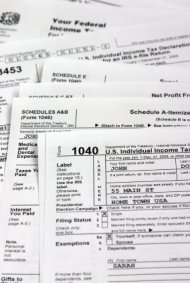 MyCorporation's 2013 small business tax guide2013 started with a bit of a bang – with the looming fiscal cliff threatening tax hikes and benefit cuts, Washington scrambled to pass a budget that would allow the USA to continue trying to climb out of the recession. However, many small business owners are wondering what this means for tax laws in 2013. Is anything going to change? Do they have to do anything special? To help sort through the chaos, MyCorporation has prepared a list of important items and small business tax advice for owners to be aware of when filling out their 2012 returns.
MyCorporation's 2013 small business tax guide2013 started with a bit of a bang – with the looming fiscal cliff threatening tax hikes and benefit cuts, Washington scrambled to pass a budget that would allow the USA to continue trying to climb out of the recession. However, many small business owners are wondering what this means for tax laws in 2013. Is anything going to change? Do they have to do anything special? To help sort through the chaos, MyCorporation has prepared a list of important items and small business tax advice for owners to be aware of when filling out their 2012 returns.
2012 Returns and Deductions
One of the biggest concerns that business owners have is how the fiscal cliff discussions will affect their 2012 returns. The American Taxpayer Relief Act of 2012, which was passed on January 1st 2013, was the piece of legislation that averted the fiscal cliff. And for many businesses, its contents will not affect their 2012 return. However, it did retroactively affect a few things, most importantly Section 179 and the Research and Experimentation Tax Credit.
- Section 179 – The deduction limit for Section 179 was raised to $500,000 back in 2010 in order to help businesses continue to invest and grow through the recession. That $500,000 limit was supposed to shrink to $139,000 in 2012, and then to $25,000 in 2013. However, the American Taxpayer Relief Act extended the $500,000 through 2013, retroactively upping the 2012 limit as well.
- What is Section 179? – If your business purchased equipment or off-the-shelf software and put that purchase into service in 2012, you can deduct the cost of those assets. Now certain things do not qualify – “Real Property,” which is typically defined as buildings, land, permanent structures, and improvements to permanent structures, do not qualify for most businesses. Neither do things like air conditioning or heating. There are other limitations as well – total equipment purchases exceeding $2 Million will lower the amount of the deduction, and the total amount of deductions cannot exceed total taxable income for the year they are being claimed. However, if you bought anything that can qualify for a Section 179 deduction – computers, office furniture, software, equipment – and the limitations of this law do no affect you, fill out Form 4562 and file it with your tax return.
- Depreciation Bonus – If your total new equipment purchases exceeded $500,000, you can claim 50% of the remaining amount as a depreciation bonus, provided you installed this equipment in 2012 and the final amount does not exceed your pre-tax profits. Software and used equipment do not qualify for the depreciation bonus.
- R&E Tax Credit – This tax credit, originally passed in the 1980’s, has once again been extended. Though it expired in 2011, recent legislation retroactively allows businesses that can claim R&E Tax credit to do so for 2012.
- Start-Up Deductions – If you started your business last year, you most likely took on a bit of debt before you even had the chance to open your doors. Luckily for you, the IRS allows you to deduct qualifying costs up to $5,000. These include:
- Money spent analyzing potential markets, workers, transportation, products, or facilities.
- Wages that you paid employees who were being trained,
- Travel expenses incurred while securing distributors, suppliers or customers
- Fees paid to consultants or for other professional services.
- Health Insurance – If you are self-employed, you can deduct the amount you paid for medical and dental insurance in 2012 for you and your family. Remember though, that you can only deduct the amount you paid for that year – even if you paid for two or three years’ worth of premiums, you can only deduct 2012’s share.
- If you run a business with fewer than 25 employees, paid average annual wages below $50,000 per full time employee, and pay for employee insurance premiums, you can fill out Form 8941 and claim tax credit – typically between 25-35% of premiums paid.
- Home Office – Though home office deductions have been simplified in the 2013 tax code, we unfortunately still have to deal with the slightly confusing jumble of regulations applicable to 2012. To qualify, your home office must be the primary place that you do business – there should be no other, fixed location where you conduct business or engage in administrative work. If you do qualify, you need to figure out what percentage of space your home office takes from the total area of your home. Then you use that percentage to determine how much of certain expenses – things like rent, deductible mortgage interest, real estate taxes, utilities, and home depreciation – that you can apply to the deduction. Keep in mind that if your gross income is less than the total amount of business expenses you are claiming, your deductions will be limited.
More Business articles from Business 2 Community:
- Having An Internet Marketing Plan Is Like Having A Facsimile Machine 15 Years Ago
- 9 Reasons QR Codes are Bad for Your Brand
- A Quick Guide to Use Labels the Right Way for Your Business
- Does Buying Google Adwords Help Your Rankings?
- Human Resource Payroll—Tip-Top Managing for People Who Manage the Company




